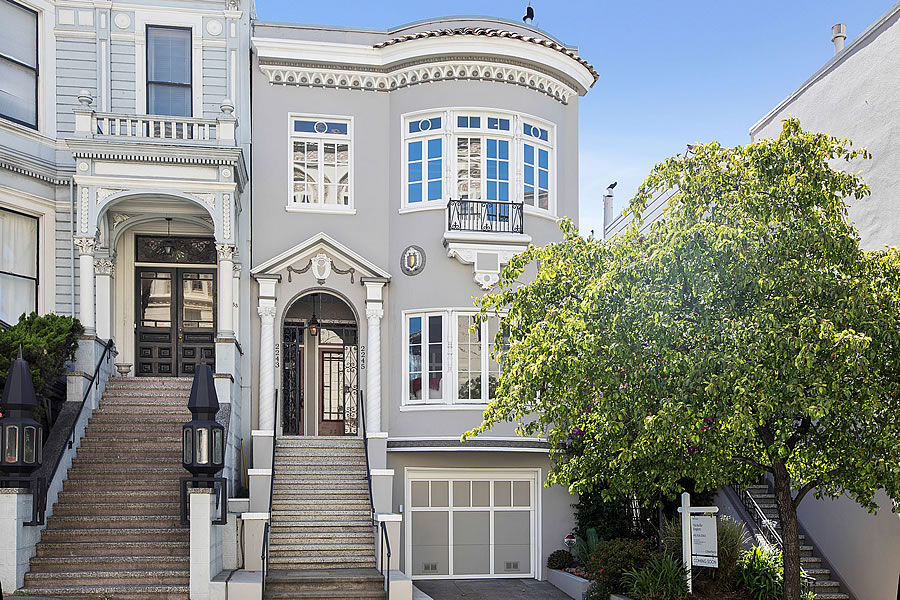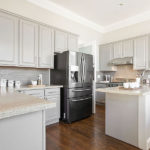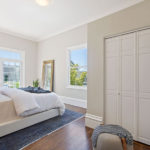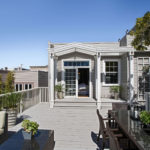Set back from street with a protected rear deck, “ideal for everyday living & entertaining,” the 1,463-square-foot, top floor condo at 2243 Franklin Street, on the edge of Pacific Heights, was purchased for $1.950 million in February of 2016.
Offering “old world San Francisco charm with today’s modern amenities,” the “dramatic full floor flat” with two bedrooms, a (previously) “updated kitchen [and] baths,” and deeded side-by-side parking in the garage, returned to the market priced at $1.995 million this past July, a sale at which would have represented total appreciation of just 2.3 percent since the first quarter of 2016.
The sale of 2243 Franklin Street has now closed escrow with a contact price of $1.855 million, down 4.9 percent on an apples-to-apples basis. And yes, the windows have been double-paned.









Lovely. Congratulations to the new owners.
For $1.9M please just build a cabinet around the fridge and use a counter depth fridge. Seriously.
And they staged it with the wrong height stools in the kitchen! No wonder it sold for a loss.
Even people who can only afford under $2M condo deserve a deep fridge!
Geez, a quarter of a million dollars lost. Wow.
How are you getting a quarter of a million dollar loss? It was purchased for $1.950MM and sold for $1.855MM. That’s only $95,000.
Add in commissions, transfer taxes, staging fees, and any loan fees they paid, and the mortgage and property taxes while the place was sitting (if they weren’t living there at the time, which it doesn’t look like they were) and you’re somewhere between $200K and a quarter mil.
Then subtract money otherwise spent in rent. Then subtract in opportunity cost leverage based off potential equity leverage loans plus a baseline stock exchange YoY, and OK. There we are.
Wait. Did no one utilize home equity lines of credit in your world, Tipster? Did no one leverage to a beneficial position in your telling?
OK. Well that’s a nice hobby you have, talking down SF real estate. Markets come,markets go. Markets spike markets fade. There’s Tipster. Saying his or her thing. How fun for you.
stocks have done well ovr past 3.5 years so considering opportunity costs would likely make it a bigger loss, but agree you do ahve to subtract out about $180K in what rent wouldve been
From a modeling perspective, if you’re subtracting out rent, don’t forget to add back the mortgage and property tax payments over the same period of time. And if you’re assuming the purchase was all cash, don’t forget to factor in an even higher cost of capital with respect to the opportunity cost.
Yay, let’s do it. S&P is up 50%. All cash purchase, they’d be up $1M, less about $6K/mo in rent, over 41 months, but they paid $2K/mo in property taxes, so we’ll net to $4K. Some of it was deductible until that ran out, but they paid an HOA over the whole term, so we’ll call it even.
Net additional loss $836K. So they lost well over $1M buying this over renting. Glad you brought it up, OC. What a catastrophe this was for them.
The myth that SF buyers don’t also have a well balanced investment portfolio in addition to real estate holdings is a Socketsite fallacy, yes, that’s true. So taking out X amount and applying it to what the market would have done instead is a thing on here. What do I know. I took all my Pets.com options and got in early on WeWork instead of buying a second condo in South Beach.
Actually, it’s the exact opposite. Recognizing that SF buyers likely do have a well balanced portfolio of investments is key to understanding the cost of capital, opportunity cost and the relative returns of different investment approaches, including “rent versus buy.”
“Markets come,markets go.”
Sure. We just had an epic boom. Now that’s over. 2020 will be an epic bloodbath. The facts and almost everyone else sees that. You and a few other poster here are the only people going mental over the obvious reality. The market came and now its going.
Oh is that right, “get real” ? Do you get to craft a new handle, “get real”?
Nobody is talking about expecting a rampant bull market.
What I am saying, is, a slightly downturn in volume, after a five yet air so Rubio, coupled with a price per foot increase, should not be interpreted as Armageddon.
That’s it. That is what I am saying. So those of you who would put words in my mouth, e gorge those words. Then talk.
Commentary on World markets in the late 20th century and on has been defined by a shareholder centric growth growth growth metric. Mere plateaus of all time highs or slight fluctuations are talked about as anathemas loss.
OK. Fine, if you allow that imo flawed Wall
street view of real estate to define yourself view. I don’t.
This site is a joke.
I really don’t want to live in luxury on a major road in Sf.
i dont see this as luxury, except for the price. its a standard fare condo
Maybe it’s just me, or the photography, but the garage door in the top picture above looks sized for tandem parking, not “side-by-side parking in the garage”.
Once you pass through the garage door, the garage probably widens to the full width of the building.
According to the Chronicle, this property should have fetched a bonus selling price since it is painted gray. One exceedingly creative broker said that gray for a house is like a tuxedo for a gentleman.
This is a pleasant enough flat, but there are many on Franklin and nearby that are larger, some much larger. Franklin has been a relative bargain for decades, since it was turned into a one-way street. The loss could have been predicted, based on the square footage, as the 2016 sale was too high.
Double-paned windows will muffle the sound. I’m sure it isn’t terrible.
I have seen several apples in the outer richmond that are increasing. This looks like another one. I believe there were not any major upgrades, and up >30% since the sale a few years ago.
They must have read the Chronicle article that Conifer is talking about. It’s painted grey inside and outside.
btw, would love to see some down apples in this neighborhood. just haven’t seen it ?
While the improvements between sales were minor, such as the removal of linoleum and refinished hardwood floors, the newly secured “permit…to add a family room & bathroom on the lower level” definitely helped.
But as with the Bay Area overall, the market for entry-level homes has been outperforming and driving the market as a whole, a trend which should actually raise a flag or two.
raise a red flag meaning what? that entry level homes shouldnt be driving the market is indicative that they are over valued and will come down? is the idea that generally growth is relativey uniform across tbe segments in the market? sorry, not quite following why that raises a flag.
The questions become: what’s driving that specific segment of the market and is it sustainable; is the compression in prices, or divergence in returns, an “alpha” or “beta” event; and what happens, on a relative basis, if there is a macro economic reckoning?